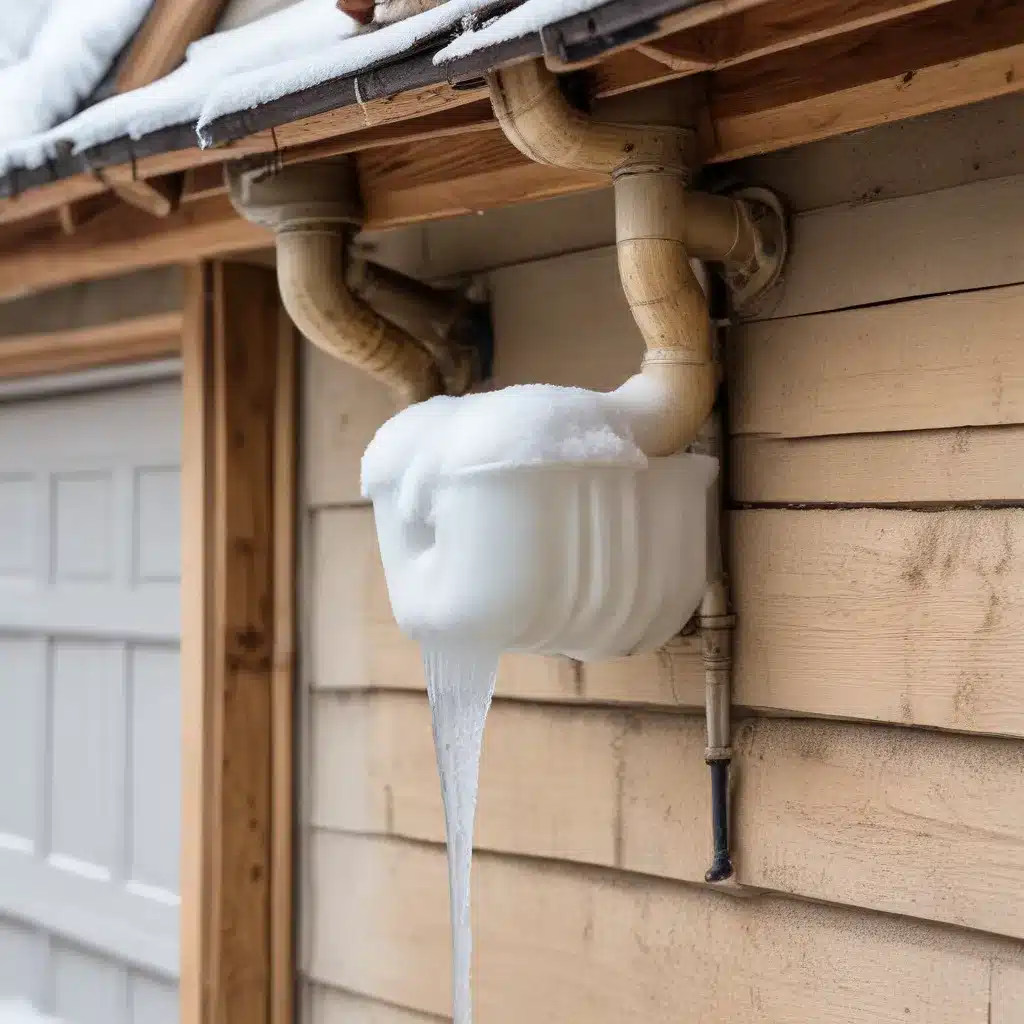
As a seasoned expert in plumbing and heating services, I’m here to provide you with practical tips and in-depth insights on maintaining, repairing, and ensuring the energy efficiency and home comfort of your plumbing systems, particularly when it comes to protecting against frozen pipes in garages and sheds.
Understanding the Risks of Frozen Pipes
Frozen pipes pose a serious threat to any property, as the expansion of water during the freezing process can lead to cracks, bursts, and costly water damage. This risk is especially heightened in spaces like garages and sheds, which often lack the insulation and climate control of a home’s interior.
When water in a pipe freezes, it expands and creates immense pressure inside the pipe. This pressure can be powerful enough to rupture even the strongest pipes, leading to a plumbing emergency and the potential for extensive water damage. Garages and sheds are particularly vulnerable due to their exposure to the elements and typically less insulated construction.
The damage from a burst pipe can be devastating, with the potential for thousands of gallons of water to flow unabated, causing structural damage, ruining equipment or inventory, and creating ideal conditions for mold growth. In commercial settings, the financial implications can be even more severe, with repair and restoration costs often averaging around $24,000 and reaching as high as $5 million in extreme cases.
Preventing Frozen Pipes in Garages and Sheds
To safeguard your property and avoid the costly consequences of frozen pipes, it’s crucial to implement a comprehensive winterization plan. Here are some essential steps to take:
Insulate Exposed Pipes
Ensure that any exposed pipes in your garage or shed, especially those running along exterior walls or in unheated spaces, are properly insulated. This can be done using pre-formed pipe insulation sleeves or wrapping the pipes with insulation and sealing it with tape.
Seal Gaps and Cracks
Carefully inspect your garage or shed for any gaps or cracks where cold air can enter, and seal them using weatherstripping, caulk, or spray foam insulation. Pay special attention to areas where pipes enter the structure, as these gaps can allow cold air to infiltrate and contribute to pipe freezing.
Maintain Proper Heating
If your garage or shed has a dedicated heating system, ensure that it is functioning correctly and set to maintain a minimum temperature of 50°F (10°C) during the winter months. This will help keep the surrounding air temperature above the freezing point and prevent pipes from freezing.
Use Heat Tapes or Cables
For particularly vulnerable pipes, consider installing heat tapes or cables that wrap around the pipes and automatically turn on when the temperature drops, providing targeted heating to prevent freezing.
Insulate Water Meters and Shut-off Valves
Don’t forget about the critical components of your plumbing system, such as the water meter and shut-off valves. Ensure these are properly insulated to prevent freezing and potential water damage.
Disconnect Outdoor Hoses
Removing and storing outdoor hoses during the winter months can help prevent water from becoming trapped in the hose and freezing, which could lead to a burst faucet or pipe.
Consider Automatic Water Shut-Off Devices
Investing in an automatic water shut-off device that can detect and respond to pipe bursts can be a valuable addition to your winterization efforts, providing an extra layer of protection in the event of a freeze.
Addressing Frozen Pipes in Garages and Sheds
Despite your best preventative measures, there’s always the possibility of encountering frozen pipes in your garage or shed. If you suspect you have a frozen pipe, it’s crucial to act quickly to prevent a potential burst and the resulting water damage. Here’s what to do:
Identify the Frozen Section
Look for signs of freezing, such as frost on the pipe, reduced water flow, or unusual noises coming from the plumbing system. Trace the pipe to locate the specific frozen section.
Thaw the Pipe
Once you’ve identified the frozen area, you can attempt to thaw the pipe using one of the following methods:
– Apply heat directly to the frozen section using a heat lamp, hair dryer, or heating pad. Take care to avoid overheating the pipe and causing damage.
– Wrap the frozen section with towels soaked in hot water and replace them as they cool.
– Use an electric heating cable or heat tape designed for pipe thawing.
Prevent Further Freezing
While working to thaw the pipe, take measures to prevent additional pipes from freezing, such as opening cabinet doors to allow warm air to circulate or using portable space heaters to maintain a consistent temperature in the area.
Seek Professional Assistance
If you’re unable to locate the frozen section, the pipe is not easily accessible, or your thawing attempts are unsuccessful, don’t hesitate to call a professional plumber. They have the expertise and specialized tools to quickly address the issue and provide valuable advice on preventing future frozen pipe incidents.
Winterizing Your Home’s Plumbing System
While this article has focused on preventing and addressing frozen pipes in garages and sheds, it’s essential to remember that your entire home’s plumbing system requires attention during the winter months. Visit the DD Plumbing and Heating website to learn more about comprehensive winterization strategies for your entire property, including insulating exposed pipes, maintaining heating systems, and ensuring the energy efficiency of your home.
By taking proactive steps to protect your plumbing and staying vigilant for the signs of frozen pipes, you can safeguard your property, avoid costly water damage, and enjoy a warm and comfortable winter season. Don’t hesitate to reach out to the experts at DD Plumbing and Heating for any questions or assistance with your winterization needs.


